When opening the University of Minnesota scholarship website[1], you will find the Wen Ping Pan Scholarship. It’s a scholarship specifically for students of Chinese descent or non-immigrant Chinese students, with a preference for students who have attended Tsing Hua University in Beijing, China. Uncovering the story from a century ago, Wen Ping Pan, a brilliant young gentleman who came to the USA in 1914, chased his dream and devoted his whole life to this country. Look back and think about the future, with many anti-Chinese riots that happened during the current U.S. – China controversial relationship, what do you think after reading his personal story below?
An Athletic Champion in Asia
Wen Ping Pan was born on October 30,1894 in Beijing. The Qing Government and Chinese had suffered a half century of wars. The foreign power countries bullied China for land, money, silk, and tea, all the while killing millions of Chinese people. The Qing Government had lost its basic right to sovereignty. By 1900, the Boxer Rebellion, an anti-foreign power uprising, involved fighting foreigner and killing Christians in Northern China around Beijing area. Pan’s grandfather Chen Ta-Yun, a Chinese Christian, as well as a local famous Methodist minister, was killed in a village during the riot. Wen Ping Pan and his family had to move to Shanghai when he was six. Yet, misfortune struck again as Pan’s father passed away two years later from disease. Pan’s mother was left alone to raise Pan and his three siblings.

Image courtesy of the University of Minnesota Archives-Twin Cities
Wen Ping Pan received traditional Chinese education when he was young, but his mother wanted him to get western education because of their Christian influence. Wen Ping Pan and his old brother, Wen Ping Huan, both got the admission to Saint John’s University. Saint John’s University is an Anglican university located in Shanghai, China. Originally founded in 1879 as “St. John’s College”, St. John’s University became its current name in 1905, and became registered in Washington, U.S.
Teaching Chinese and English as its the main language, focusing on science and natural philosophy, St. John’s University was well known for its incredibly strict matriculation. The matriculation took up to 6 days with only a one-day exam using Chinese. Physical education and sports were introduced and quickly sought for by students. This led to the first soccer team in China to be established in St. John’s University.

The connection between physical exertion and the national strength was an obvious path for Chinese populace to support in the 1910s.
The First National Athletic Alliance of Regional Student Teams (全国学校区分队第一次体育同盟会) was held on October 18-22, 1910 in Nanjing, under the auspices of Qing Government. On the grounds of the Nanyang Industrial Exposition near Nanjing’s Xuanwu Gate, nearly 40,000 people attended this national meet. The scene was described as, “this exposition, this great celebration of and monument to the contraction of a capitalist economy, a capitalist labor discipline, and a modern ethos of production and consumption in China, seems the perfect moment for such a breakthrough in Chinese national Strength, modernity, and integration.” [2] Wen Ping Pan displayed his athletic gift in this meet, winning in both the 120-yard hurdle race and the high jump.[3]
The Qing imperial Court using the Boxer Indemnity established the China Institute along with a preparatory school in 1909. This school was renamed Tsinghua College on April 29th, 1911. Again, Wen Ping Pan followed his brother and attended Tsinghua College in his Junior year. At the beginning when Tsinghua College was established, physical education was one of ten major programs. Only those who passed the PE exam could study abroad. A few memoirs written by famous Tsinghua scholars still recalled the strictness of PE training and exam in their vivid narratives[4]. Tsinghua College had many sport teams including: soccer, basketball, baseball, track, tennis, as well as Jiji Hui (技击会), a sport focused on traditional martial arts. Wen Ping Pan was extremely qualified as he was the captain of the soccer team in St. John’s University and Tsinghua College.
Wen Ping Pan was preparing to study abroad in 1913. However, due to the government power change lead by President Yuan Shi Kai (袁世凯), no students were sent to the United States. Wen Ping Pan stayed at Tsinghua College and became an assistant in chemistry department and a coach of several sports teams. During this period, Wen Ping Pan took part in two athletic meets and presented his sports score at the international level.
The Far Eastern Olympiad was held on February 3-7, 1913, in Manila, Philippines. It was also known as the “First Oriental Olympic Games.” China, Philippines, Japan, British East Indies (now known as Malaysia) and Thailand sent athletics to attend the event. Wen Ping Pan participated in tennis, soccer, and track. He won first place in the track and became an athletic champion in Asia.
In the Far Eastern Olympiad, he participated in the decathlon which involved ten different athletics events that would be held over two consecutive days. It included 100 yards, 440 yards, one mile run, 220 yards hurdles, High jump, long jump, hop step and jump, 16-pound shot put, discus throw and pole vault. He scored a total of 598, the first place.
He also participated in the pentathlon, a shorter decathlon with five events, including hurdles, shot put 16-pounds, 220 yards, Discus throw, and one mile run. Pan scored 262, which was the second place. The game awarded the top 5 athletes, Wen Ping Pan was the one of them.[5]
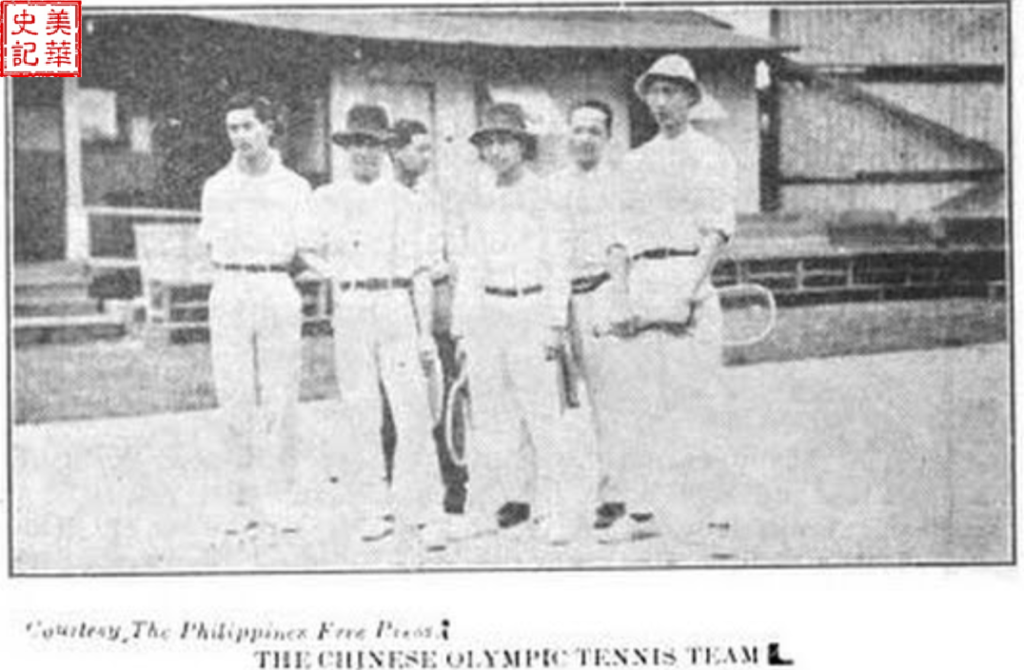
From Philippine Education. March 1913 Vol IX, No. 9
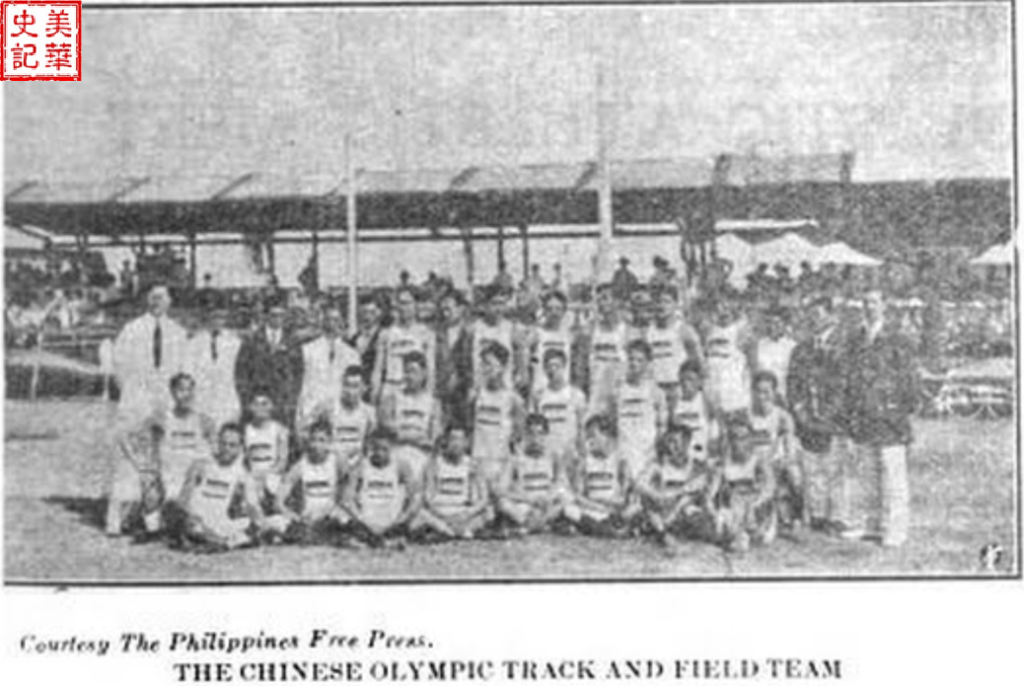
From Philippine Magazine, Volumes 8-9 Page 370
May 24, 1913 was the date that the First All North China Track and Field Meet, under the auspices of the Peking Amateur Athletic Association, was held at the Temple of Heaven( 天坛). It was the first time in the history for Beijing and for the sacred Temple of Heaven to hold such an athletic meet. A total of 257 entrants from thirty-five schools and colleges representing eight northern provinces participated in the sports. To continue the grand picture, more than twelve thousand audience watch the event unfold. President Yuan Shi Kai(袁世凯) presented two silver cups, one to the most successful student, other to the most successful college. Continuing his steak of success, Wen Ping Pan won President Yuan’s individual silver cup by the first prizes of the 100 yards dash, broad jump, 229 hurdles and 120 yards hurdles[6].
The Republican Advocate of China, a weekly journal in English, wrote an article entitled “The First North-China Athletic Meet”. From a slice of photo and word published in that article, a historical event shown in detail, including Wen Ping Pan’s astounding athletic skills and talents. [7]
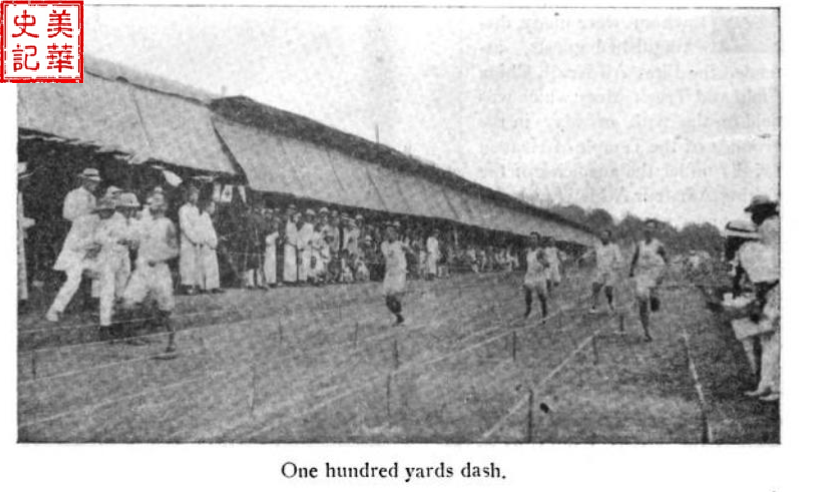

A month later, the first annual field day was held at Tsinghua College on June 22,1913, under the auspices of the Student Athletic Association. American physical education review. v.18 (1913) had the records for this event. Once again, Wen Ping Pan earned recognition in the events below[8].
| Program of Events | Records | Rank |
| 100-yard Dash | 11 seconds | 1 |
| Discus Throw | 97 feet 9 inches | 1 |
| Running Broad Jump | 19 feet 6 inches | 1 |
| Running High Jump | 4 feet 10 inches | 1 |
| Shot Put (12 lbs.) | 32 feet 5 inches | 1 |
| 300-yard Run | 39 seconds | 1 |
| Throwing Baseball | 182 feet 5 inches | 2 |
Study in the United States
Tsinghua College resumed sending students to the United States in 1914. Wen Ping Pan took a “China” steamboat crossing the Pacific Ocean in August 1914. He traveled with a large group people including students from preparatory school, senor graduated students from 1913 and 1914, and nine female students just received enrollment in 1914. Below is the picture of the students who studied abroad in 1914[9].

资料来源《清华大学一百年》,清华大学校史研究室编,清华大学出版社,2011。
Wen Ping Pan arrived in Minnesota, becoming the first Chinese student at the University of Minnesota. Founded in 1851, The U of M was one of the earliest universities sending faculty and students to China, as well as accepting Chinese students on Campus. Recommended from his American chemistry teacher back in China, Pan enrolled in the Chemistry Department. Shortly later, he convinced his brother, Wen Huan Pan (潘文焕), and his best friend, Harding Kwong (邝翼堃), into transferring to the U of M.
His brother, Wen Huan Pan (潘文焕), arrived at the United Stated earlier. Before transferring to the U of M in 1914, his first stop was at the Engineering Department in Michigan University. There exists article writing his name as Pan Wen Huen (潘文辉). However, it was incorrect according to historical resources both USA and China (see below imagine shown his name with the correct information). Harding Kwong (邝翼堃) was born in Xingning, Guangdong. He started at Colorado School of Mine in 1910, then went to the University of Chicago, and finally transferred to the U of M in 1914.

All three of them had studied at St. John’s University, Tsinghua College, and came to the United States supporting by Boxer Indemnity, all the while holding astounding athletic talent. It is a brilliant view in the University of Minnesota history. They helped organize the University’s first soccer club and won the Champion in the 1914 soccer season. “The Pan brothers were known for their passing and dribbling skills that surpassed those from other teams.”[10] Wen Ping Pan was selected as the captain for the University soccer team. His brother, Wen Huan Pan, was selected as the captain for both the University tennis and hockey team. In the 1917 University Gopher yearbook, it was said “When it comes to real all-around playing ability and goal getting, first honor must be awarded to Wen Ping Pan, the Chinese forward, who is without doubt the best forward in the Northwest, either in college or out. W. H. Pan in the forward line also played an excellent game.”

Image courtesy of the University of Minnesota Archives, University of Minnesota – Twin Cities
Image: University of Minnesota Soccer team won the championship in 1914, Wen Ping Pan (Second left in the middle row), Wen Huan Pan (Second Right in the middle row), Harding Kwong (Second Left in the first row).
Bau Ching Ling(鲍庆林), another friend of Wen Ping Pan, transferred from the University of Illinoi to the U of M in 1915. The Pan brothers, along with Kwong and Bau, lived in a building on the 4th street[11]. They organized the first Chinese Student Club; Pan became the chairman of the club in 1915. Pan was also a member of Cosmopolitan Club and severed vice-chairman in 1916 and 1917 consecutively. Besides that, he was the second tenorist in the Glee Club from 1914 to 1915, and a board member of YMCA in 1917.
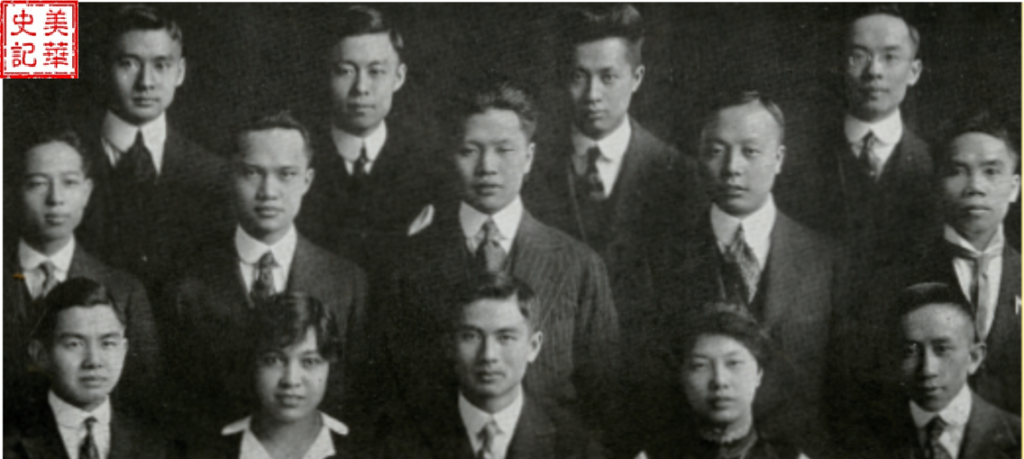
Image courtesy of the University of Minnesota Archives, University of Minnesota – Twin Cities
Image: The First Chinese Student Club, Wen Ping Pan (third left in the first row), Wen Huan Pan (first left in the third row), Harding Kwong (second left in the middle row), Yuantai Miao (first right in the first row) in 1916 Gopher yearbook.
Mining Engineer
Wen Ping Pan graduated and got a B.S. degree in chemistry in 1918. During that summer, he got an engineer’s assistant job in Oliver Mining Company, which is located at a small town, Chisholm, in northern Minnesota.
The gold rush in northern Minnesota led to the discovery of iron ore ranges in 1860s. At that time, it turned out that Minnesota had the greatest amount of iron ore in the world. The Mines attracted thousands of immigrants from almost every country in Europe. Small villages were built around the mines and grown into bigger towns. As the matter of fact, during the World War I and II, iron would become more valuable than gold. In the whole world, about a half production of iron ore was produced in Minnesota during 1930-1935. Until 1951, the incredible fact was that about 82% of world iron ore was produced in Minnesota[12].

Image courtesy of the University of Minnesota CSE Twin Cities[13]
This summer job experience gave Wen Ping Pan such a profound impression that he spent one more year at the U of M to study mining. As one of the first graduate students from the School of Mines, he got M.A. degree in metallurgical engineering in 1919 [14]. Then he went to South Dakoda and worked in a gold mine for field experience before accepting a full-time position with the Oliver Mining Division in Hibbing, Minnesota. Pan worked over there starting from a mining engineer and eventually became an assistant chief mining engineer[15].

From Who’s who in Engineering, Volume 1
edited by John William Leonard, Winfield Scott Downs, M. M. Lewis
With the developing of mining ranges, the Oliver Mining Company decided to pay for the entire Hibbing city to be moved south about two miles in 1922. Pan was asked to help this big relocation job. This was not an easy job because residents were unhappy and had various demands. Although “he was an engineer, not a customer service representative”, said his grandson, Pan was calm and never got emotional with the challenge. An attorney said it might be the Oliver’s plan that Pan especially was signed for the job to keep the complaints from catching any law sue[16] .
Pan also helped design the Howard business district and many of the downtown buildings in Hibbing[17].
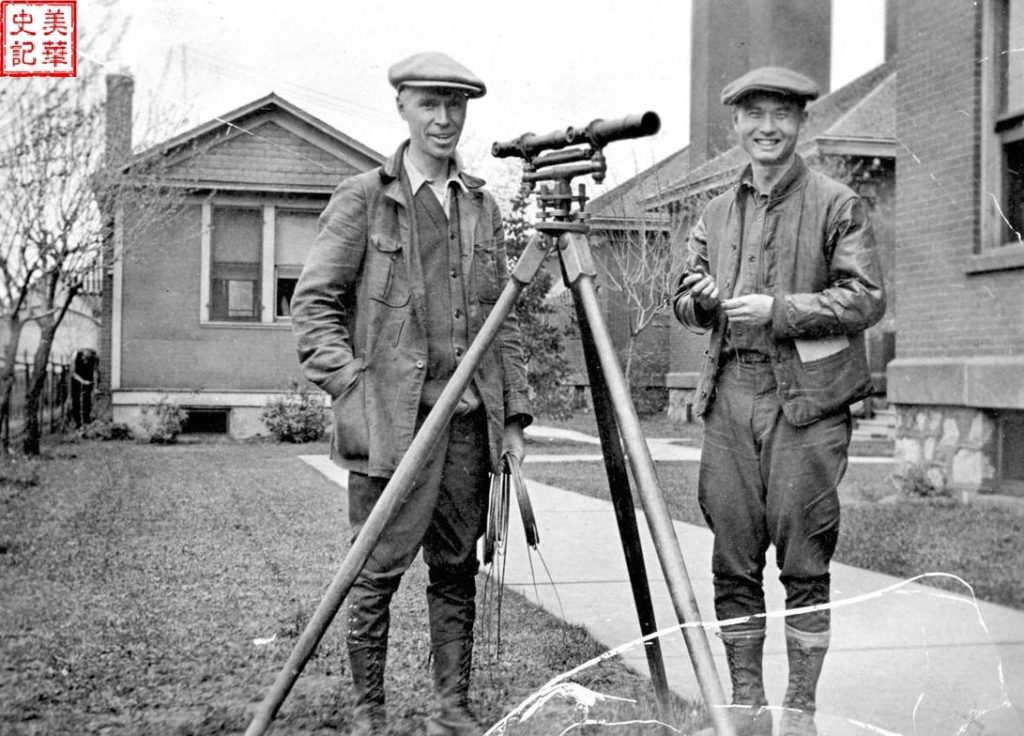
Wen Ping Pan (right) working on the Hibbing’s new townsite in 1922 http://minnesotabrown.com/2017/04/chinese-engineer-american-life-hibbing.html
Wen Ping Pan got married with Mae Humm in 1923. Mae Humm also was Pan’s classmate in the University of Minnesota. They had a son, named Harding Pan. Originally, they wanted to return to China, but it was a period full of turmoil due to years of Japanese invasion into China. Both Pan’s old brother and his friends let them stay in Hibbing for the time being, but nobody know they ended up living in Hibbing for their whole life. During the Great Depression, Pan suffered the pain of losing job from 1929 to 1931. However, the difficult life did not prevent him from supporting Chinese during the China-Japan War in WWII. Madame Chiang Kai-shek sent him a certificate of appreciation for his efforts according to his family communication.[18]
Wen Ping Pan never stopped his athletic activities and was well known in Hibbing too. A tennis courts at the Lincoln Middle school were named for “William Pan Tennis Courts” in 1950s. After working 40 years at the Oliver, Pan retired in 1959. The company threw him a big party at the Elks Club in Hibbing. The local newspaper, Chisholm Tribune Press, wrote “he lived each day as if it were a precious jasmine blossom. He was that kind of man … everything he did, he did extremely well.”[19]

Pan’s family picture on his retirement party The Nov. 3, 1959, Chisholm Tribune-Press
Pan died on Oct. 20, 1981, at age of 86. Wen Ping Pan studied, worked, lived in Minnesota for 68 years, devoting his whole life in this land, just like the article title on Chisholm Tribune Press “Mr. Pan – A Real American”. His body lies Lakewood Cemetery.

Lakewood Cemetery https://www.findagrave.com/memorial/124176554
[1] https://admissions.tc.umn.edu/cost-aid/scholarships/university-wide-academic-scholarships
[2] Andrew Morris, Mastery Without Enmity:˙Athletics, Modernity and the Nation in Early Republican China. Republican China, 1997-04, Vol.22 (2), p.3-39
[3] 徐梁伯,蒋顺兴 (编). 第六章 江苏教育、文化的变革. 《江苏通史 晚清卷》. 凤凰出版社. 2012.
[4] 民国时期的体育http://www.2499cn.com/wenhua/32.htm
[5] From Philippine Magazine, Volumes 8-9 Page 370
https://books.google.com/books?id=BCY4AQAAMAAJ
[6] The Republican Advocate: Of China, Volume 2, Part 2
[7] The Republican Advocate: Of China, Volume 2, Part 2 https://www.google.com/books/edition/_/Ey5BAQAAMAAJ?hl=en&gbpv=1&bsq=PAN
[8] American physical education review. v.18 (1913)
[9] 资料选自《清华大学一百年》,清华大学校史研究室编,清华大学出版社,2011。
[10] Minnesota: A Rich Soccer History. https://fiftyfive.one/2015/04/minnesota-rich-soccer-history/
[11] Hui Bi,Looking into the Mirror of History: Educational Relations between the University of Minnesota and China(1914-2018).
[12] http://news.minnesota.publicradio.org/features/2006/05/rangetimeline/index.shtml
[13] https://cse.umn.edu/college/feature-stories/retrospect-celebrating-first-students-china
[14] IBID
[15] Hui Bi. IBID
[16] The Chinese engineer who mined an American Life on Minnesota’s Iron Range http://minnesotabrown.com/2017/04/chinese-engineer-american-life-hibbing.html
[17] https://www.hmdb.org/marker.asp?marker=126663
[18] Hui Bi. IBID
[19] The Chinese engineer who mined an American Life on Minnesota’s Iron Rangehttp://minnesotabrown.com/2017/04/chinese-engineer-american-life-hibbing.html